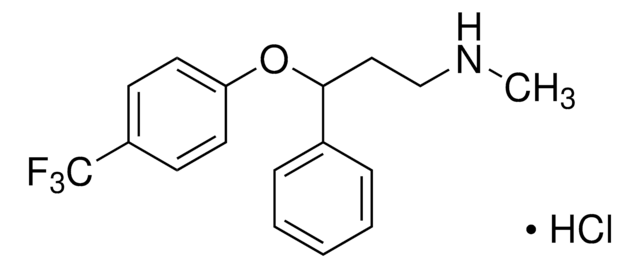SML0474
(S)-Duloxetine hydrochloride
≥98% (HPLC)
Sinónimos:
(γS)-N-Methyl-γ-(1-naphthalenyloxy)-2-thiophenepropanamine hydrochloride, (+)-(S)-N-Methyl-γ-(1-naphthyloxy)-2-thiophenepropylamine hydrochloride, (+)-N-Methyl-3-(1-naphthalenyloxy)-3-(2-thienyl)propanamine hydrochloride, LY-248686 hydrochloride
About This Item
Productos recomendados
Análisis
≥98% (HPLC)
formulario
powder
actividad óptica
[α]/D +116 to +125°, c = 1 in methanol
condiciones de almacenamiento
desiccated
color
white to beige
solubilidad
H2O: 5 mg/mL (clear solution, warmed)
temp. de almacenamiento
room temp
cadena SMILES
Cl.CNCC[C@H](Oc1cccc2ccccc12)c3cccs3
InChI
1S/C18H19NOS.ClH/c1-19-12-11-17(18-10-5-13-21-18)20-16-9-4-7-14-6-2-3-8-15(14)16;/h2-10,13,17,19H,11-12H2,1H3;1H/t17-;/m0./s1
Clave InChI
BFFSMCNJSOPUAY-LMOVPXPDSA-N
Información sobre el gen
human ... SLC6A2(6530) , SLC6A4(6532)
¿Está buscando productos similares? Visita Guía de comparación de productos
Descripción general
Aplicación
Acciones bioquímicas o fisiológicas
Características y beneficios
Precaución
Palabra de señalización
Warning
Frases de peligro
Consejos de prudencia
Clasificaciones de peligro
Acute Tox. 4 Oral
Código de clase de almacenamiento
11 - Combustible Solids
Clase de riesgo para el agua (WGK)
WGK 3
Punto de inflamabilidad (°F)
Not applicable
Punto de inflamabilidad (°C)
Not applicable
Certificados de análisis (COA)
Busque Certificados de análisis (COA) introduciendo el número de lote del producto. Los números de lote se encuentran en la etiqueta del producto después de las palabras «Lot» o «Batch»
¿Ya tiene este producto?
Encuentre la documentación para los productos que ha comprado recientemente en la Biblioteca de documentos.
Los clientes también vieron
Nuestro equipo de científicos tiene experiencia en todas las áreas de investigación: Ciencias de la vida, Ciencia de los materiales, Síntesis química, Cromatografía, Analítica y muchas otras.
Póngase en contacto con el Servicio técnico







